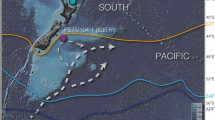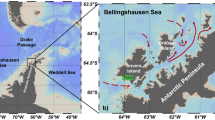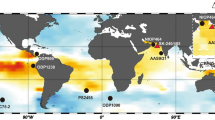Abstract
Glacial–interglacial changes in atmospheric CO2 are generally attributed to changes in seawater carbon chemistry in response to large-scale shifts in the ocean’s biogeochemistry and general circulation. The Southern Ocean currently takes up more CO2 than any other and it is likely to have played a crucial role in regulating past atmospheric CO2. However, the physical, biological and chemical variables that control ocean–atmosphere CO2 exchange during glacial–interglacial cycles are not completely understood. Here we use boron isotopes and carbon isotopes in planktonic foraminifera and an alkenone-based proxy of temperature to reconstruct seawater pH and CO2 partial pressure in sub-Antarctic surface waters south of Tasmania over the past 25,000 years, and investigate the mechanisms that regulate seawater CO2. The new record shows that surface waters in this region were a sink for atmospheric CO2 during the Last Glacial Maximum. Our reconstruction suggests changes in the strength of the biological pump and the release of deep-ocean CO2 to surface waters contributed to the last deglacial rise in atmospheric CO2. These findings demonstrate that variations in upwelling intensity and the distribution of Southern Ocean water masses in this sector played a key role in regulating atmospheric CO2 during the last glacial–interglacial cycle.
This is a preview of subscription content, access via your institution
Access options
Access Nature and 54 other Nature Portfolio journals
Get Nature+, our best-value online-access subscription
$29.99 / 30 days
cancel any time
Subscribe to this journal
Receive 12 print issues and online access
$259.00 per year
only $21.58 per issue
Buy this article
- Purchase on Springer Link
- Instant access to full article PDF
Prices may be subject to local taxes which are calculated during checkout





Similar content being viewed by others
Data availability
All data are archived at the Australian Antarctic Data Centre (https://data.aad.gov.au/) and are publicly accessible at https://doi.org/10.26179/5d5df822acf6c.
References
Bereiter, B. et al. Revision of the EPICA Dome C CO2 record from 800 to 600 kyr before present. Geophys. Res. Lett. 42, 542–549 (2015).
Sigman, D. M., Hain, M. P. & Haug, G. H. The polar ocean and glacial cycles in atmospheric CO2 concentration. Nature 466, 47–55 (2010).
Ciais, P. et al. Large inert carbon pool in the terrestrial biosphere during the Last Glacial Maximum. Nat. Geosci. 5, 74–79 (2011).
Ciais, P. et al. in Climate Change 2013: The Physical Science Basis (eds T. F. Stocker et al.) Ch. 6 (IPCC, Cambridge Univ. Press, 2013).
Winterfeld, M. et al. Deglacial mobilization of pre-aged terrestrial carbon from degrading permafrost. Nat. Commun. 9, 3666 (2018).
Sarmiento, J. L. & Toggweiler, J. R. A new model for the role of the oceans in determining atmospheric \(p_{{\rm{CO}}_2}\). Nature 308, 621–624 (1984).
Sigman, D. M. & Boyle, E. A. Glacial/interglacial variations in the atmospheric carbon dioxide. Nature 407, 859–869 (2000).
Toggweiler, J. R., Russell, J. L. & Carson, S. R. Midlatitude westerlies, atmospheric CO2, and climate change during ice ages. Paleoceanography 21, PA2005 (2006).
Anderson, R. F., Chase, Z., Fleisher, M. Q. & Sachs, J. The Southern Ocean’s biological pump during the Last Glacial Maximum. Deep Sea Res. Part II 49, 1909–1938 (2002).
Skinner, L. C. et al. Ventilation of the deep Southern Ocean and deglacial CO2 rise. Science 328, 1147–1151 (2010).
Burke, A. & Robinson, L. F. The Southern Ocean’s role in carbon exchange during the last deglaciation. Science 335, 557–561 (2012).
Martínez-García, A. et al. Iron fertilization of the Subantarctic ocean during the last ice age. Science 343, 1347–1350 (2014).
Martínez-Botí, M. A. et al. Boron isotope evidence for oceanic carbon dioxide leakage during the last deglaciation. Nature 518, 219–222 (2015).
Jaccard, S. L., Galbraith, E. D., Martínez-García, A. & Anderson, R. F. Covariation of deep Southern Ocean oxygenation and atmospheric CO2 through the last ice age. Nature 530, 207–210 (2016).
Ronge, T. A. et al. Radiocarbon constraints on the extent and evolution of the South Pacific glacial carbon pool. Nat. Commun. 7, 11487 (2016).
Kohfeld, K. E. & Chase, Z. Temporal evolution of mechanisms controlling ocean carbon uptake during the last glacial cycle. Earth Planet. Sci. Lett. 472, 206–215 (2017).
Rae, J. W. B. et al. CO2 storage and release in the deep Southern Ocean on millennial to centennial timescales. Nature 562, 569–573 (2018).
Locarnini, R. A. et al. World Ocean Atlas 2013, Vol. 1: Temperature NOAA Atlas NESDIS 73 (eds Levitus, S. & Mishonov, A.) (US Department of Commerce, 2013).
Conkright, M., Levitus, S. & Boyer, T. The World Ocean Atlas 1994 Volume 1: Nutrients NOAA Atlas NESDIS 1 (US Department of Commerce, 1994).
Sikes, E. L. et al. Southern Ocean seasonal temperature and Subtropical Front movement on the South Tasman Rise in the late Quaternary. Paleoceanography 24, PA2201 (2009).
Schrag, D. P. et al. The oxygen isotopic composition of seawater during the Last Glacial Maximum. Quat. Sci. Rev. 21, 331–342 (2002).
Spero, H. J., Bijma, J., Lea, D. W. & Bemis, B. E. Effect of seawater carbonate concentration on foraminiferal carbon and oxygen isotopes. Nature 390, 497–500 (1997).
Bemis, B. E., Spero, H. J., Bijma, J. & Lea, D. W. Reevaluation of the oxygen isotopic composition of planktonic foraminifera: experimental results and revised paleotemperature equations. Paleoceanography 13, 150–160 (1998).
Bemis, B. E., Spero, H. J., Lea, D. W. & Bijma, J. Temperature influence on the carbon isotopic composition of Globigerina bulloides and Orbulina universa (planktonic foraminifera). Mar. Micropaleontol. 38, 213–228 (2000).
Barker, S. & Elderfield, H. Foraminiferal calcification response to glacial–interglacial changes in atmospheric CO2. Science 297, 833–836 (2002).
Bijma, J., Honisch, B. & Zeebe, R. E. Impact of the ocean carbonate chemistry on living foraminiferal shell weight: comment on “Carbonate ion concentration in glacial-age deep waters of the Caribbean Sea” by W.S. Broecker and E. Clark. Geochem. Geophys. Geosyst. 3, 1064 (2002).
Foster, G. L. & Rae, J. W. B. Reconstructing ocean pH with boron sotopes in foraminifera. Annu. Rev. Earth Planet. Sci. 44, 207–237 (2016).
Broecker, W. S. & Clark, E. Glacial to Holocene redistribution of carbonate ion in the deep sea. Science 294, 2152–2155 (2001).
Moy, A. D., Howard, W. R., Bray, S. G. & Trull, T. W. Reduced calcification in modern Southern Ocean planktonic foraminifera. Nat. Geosci. 2, 276–280 (2009).
Raitzsch, M. et al. Boron isotope-based seasonal paleo-pH reconstruction for the Southeast Atlantic—a multispecies approach using habitat preference of planktonic foraminifera. Earth Planet. Sci. Lett. 487, 138–150 (2018).
Shoenfelt, E. M. et al. Highly bioavailable dust-borne iron delivered to the Southern Ocean during glacial periods. Proc. Natl Acad. Sci. USA 115, 11180–11185 (2018).
Kumar, N. et al. Increased biological productivity and export production in the glacial Southern Ocean. Nature 378, 675–680 (1995).
Elderfield, H. & Rickaby, R. E. M. Oceanic Cd/P ratio and nutrient utilization in the glacial Southern Ocean. Nature 405, 305–310 (2000).
Chase, Z., Anderson, R. F., Fleisher, M. Q. & Kubik, P. W. Accumulation of biogenic and lithogenic material in the Pacific sector of the Southern Ocean during the past 40,000 years. Deep Sea Res. Part II: Top. Stud. Oceanogr. 50, 799–832 (2003).
Francois, R. et al. Contribution of Southern Ocean surface-water stratification to low atmospheric CO2 concentrations during the Last Glacial Period. Nature 389, 929–935 (1997).
Abelmann, A. et al. The seasonal sea-ice zone in the glacial Southern Ocean as a carbon sink. Nat. Commun. 6, 8136 (2015).
Basak, C. et al. Breakup of last glacial deep stratification in the South. Pac. Sci. 359, 900–904 (2018).
Sikes, E. L., Cook, M. S. & Guilderson, T. P. Reduced deep ocean ventilation in the Southern Pacific Ocean during the last glaciation persisted into the deglaciation. Earth Planet. Sci. Lett. 438, 130–138 (2016).
Kohfeld, K. E., Quéré, C. L., Harrison, S. P. & Anderson, R. F. Role of marine biology in glacial–interglacial CO2 cycles. Science 308, 74–78 (2005).
Broecker, W. S. & Peng, T.-H. Tracers in the Sea (Eldigio Press, 1982).
Villanueva, J. et al. A latitudinal productivity band in the central North Atlantic over the last 270 kyr: an alkenone perspective. Paleoceanography 16, 617–626 (2001).
Ziegler, M., Diz, P., Hall, I. R. & Zahn, R. Millennial-scale changes in atmospheric CO2 levels linked to the Southern Ocean carbon isotope gradient and dust flux. Nat. Geosci. 6, 457–461 (2013).
Hasenfratz, A. P. et al. The residence time of Southern Ocean surface waters and the 100,000-year ice age cycle. Science 363, 1080–1084 (2019).
Moreno, P. I., Francois, J. P., Moy, C. M. & Villa-Martínez, R. Covariability of the Southern Westerlies and atmospheric CO2 during the Holocene. Geology 38, 727–730 (2010).
Saunders, K. M. et al. Holocene dynamics of the Southern Hemisphere westerly winds and possible links to CO2 outgassing. Nat. Geosci. 11, 650–655 (2018).
Anderson, R. F. et al. Wind-driven upwelling in the Southern Ocean and the deglacial rise in atmospheric CO2. Science 323, 1443–1448 (2009).
Spero, H. J. & Lea, D. W. The cause of carbon isotope minimum events on glacial terminations. Science 296, 522–525 (2002).
Takahashi, T. et al. The changing carbon cycle in the Southern Ocean. Oceanography 25, 26–37 (2012).
Le Quéré, C. et al. Saturation of the Southern Ocean CO2 sink due to recent climate change. Science 316, 1735–1738 (2007).
Landschützer, P. et al. The reinvigoration of the Southern Ocean carbon sink. Science 349, 1221–1224 (2015).
Trull, T. W., Bray, S. G., Manganini, S. J. & Francois, R. Moored sediment trap measurements of carbon export in the Subantarctic and Polar Frontal Zones of the Southern Ocean, south of Australia. J. Geophys. Res. 106, 31489–31509 (2001).
King, A. L. & Howard, W. R. δ18O seasonality of planktonic foraminifera from the Southern Ocean sediment traps: latitudinal gradients and implications for paleoclimate reconstructions. Mar. Micropaleontol. 56, 1–24 (2005).
Moy, A. D., Howard, W. R. & Gagan, M. K. Late Quaternary palaeoceanography of the Circumpolar Deep Water from the South Tasman Rise. J. Quat. Sci. 21, 763–777 (2006).
Stuiver, M., Reimer, P. J. & Reimer, R. W. CALIB 7.1 (2018); http://calib.org
Reimer, P. J. et al. IntCal13 and marine13 radiocarbon age calibration curves 0–50,000 years cal bp. Radiocarbon 55, 1869–1887 (2013).
Reimer, P. J. & Reimer, R. W. A marine reservoir correction database and on-line interface. Radiocarbon 43, 461–463 (2001).
Sikes, E. L., Samson, C. R., Guilderson, T. P. & Howard, W. R. Old radiocarbon ages in the southwest Pacific Ocean during the last glacial period and deglaciation. Nature 405, 555–559 (2000).
Palmer, M. R. et al. Multi-proxy reconstruction of surface water \(p_{{\rm{CO}}_2}\) in the northern Arabian Sea since 29 ka. Earth Planet. Sci. Lett. 295, 49–57 (2010).
Palmer, M. R. & Pearson, P. N. A 23,000-year record of surface pH and \(\Delta p_{{\rm{CO}}_2}\) in the Western Equatorial Pacific. Ocean. Sci. 300, 480–482 (2003).
Palmer, M. R., Pearson, P. N. & Cobb, S. J. Reconstructing past ocean pH-depth profiles. Science 282, 1468–1471 (1998).
Barker, S., Greaves, M. & Elderfield, H. A study of cleaning procedures used for foraminiferal Mg/Ca paleothermometry. Geochem. Geophys. Geosyst. 4, 8407 (2003).
Rae, J. W. B., Foster, G. L., Schmidt, D. N. & Elliott, T. Boron isotopes and B/Ca in benthic foraminifera: proxies for the deep ocean carbonate system. Earth Planet. Sci. Lett. 302, 403–413 (2011).
Calvo, E., Pelejero, C. & Logan, G. A. Pressurized liquid extraction of selected molecular biomarkers in deep sea sediments used as proxies in paleoceanography. J. Chromatogr. A 989, 197–205 (2003).
Müller, P. J. et al. Calibration of the alkenone paleotemperature index \({\mathrm{U}}_{37}^{{\mathrm{K}}\prime }\) based on core-tops from the eastern South Atlantic and the global ocean (60° N–60° S). Geochim. Cosmochim. Acta 62, 1757–1772 (1998).
Waelbroeck, C. et al. Sea-level and deep water temperature changes derived from benthic foraminifera isotopic records. Quat. Sci. Rev. 21, 295–305 (2002).
R Development Core Team A Language and Environment for Statistical Computing (R Foundation for Statistical Computing, 2013); http://www.R-project.org/
Gattuso, J.-P. Seacarb: Seawater Carbonate Chemistry with R R package version 3.1.1 https://cran.r-project.org/package=seacarb (2011).
Hain, M. P., Foster, G. L. & Chalk, T. Robust constraints on past CO2 climate forcing from the boron isotope proxy. Paleoceanogr. Paleoclimatol. 33, 1099–1115 (2018).
Dickson, A. G. Thermodynamics of the dissociation of boric acid in synthetic seawater from 273.15 to 318.15 K. Deep Sea Res. Part A 37, 755–766 (1990).
Klochko, K. et al. Experimental measurement of boron isotope fractionation in seawater. Earth Planet. Sci. Lett. 248, 276–285 (2006).
Lauvset, S. K. et al. A new global interior ocean mapped climatology: the 1° × 1° GLODAP version 2. Earth Syst. Sci. Data 8, 325–340 (2016).
Sikes, E. L., O’Leary, T., Nodder, S. D. & Volkman, J. K. Alkenone temperature records and biomarker flux at the subtropical front on the Chatham Rise, SW Pacific Ocean. Deep Sea Res. Part I 52, 721–748 (2005).
Tilbrook, B. & Rintoul, S. Hydrographic, Chemical and Total CO 2 Data Obtained during RSV Aurora Australis in the Southern Pacific Ocean during WOCE section P12 SR3/S04 (EXPOCODE 09AR9404_1) (13 December 1994—02 February 1995) (Carbon Dioxide Information Analysis Center, Oak Ridge National Laboratory, 1995); http://cdiac.ornl.gov/ftp/oceans/p12woce/
Tilbrook, B., Rintoul, S. & Sabine, C. L. Carbon Dioxide, Hydrographic and Chemical Data Obtained during R/V Aurora Australis Repeat Hydrography Cruise in the Southern Ocean: CLIVAR CO 2 Repeat Section SR03_2001 (EXPOCODE AA0301) (29 October–22 November 2001) (Carbon Dioxide Information Analysis Center, Oak Ridge National Laboratory, 2001); http://cdiac.ornl.gov/ftp/oceans/CLIVAR/SR03_AA0301_2001.data/
Tilbrook, B., McNeil, B. & Rosenberg, M. Hydrographic, Chemical and Carbon Data Obtained during RSV Aurora Australis in the Southern Pacific Ocean during WOCE section SR03 (EXPOCODE 09AR19980228) (28 February–01 April 1988) (Carbon Dioxide Information Analysis Center, Oak Ridge National Laboratory, 2013); http://cdiac.ornl.gov/ftp/oceans/sr03_98_woce/
McNeil, B. I. & Tilbrook, B. A seasonal carbon budget for the sub-Antarctic Ocean, South of Australia. Mar. Chem. 115, 196–210 (2009).
Sarmiento, J. L. et al. A new estimate of the CaCO3 to organic carbon export ratio. Glob. Biogeochem. Cycles 16, 1107 (2002).
King, A. L. & Howard, W. R. Planktonic foraminiferal δ13C records from Southern Ocean sediment traps: new estimates of the oceanic Suess effect. Glob. Biogeochem. Cycles 18, GB2007 (2004).
Acknowledgements
This work was supported by the Australian Antarctic Division (AAS 4061) and the Australian Government’s Cooperative Research Centres Programme through the Antarctic Climate and Ecosystems Cooperative Research Centre (ACE CRC). The boron isotope analyses were supported by the European Union 5th Framework Programme project 6C (Project ID: EVK2-CT-2002-00135 6 C). E.C. and C.P. acknowledge Graham Logan and Geoscience Australia for providing analytical facilities for alkenone analyses. We thank the French Polar Institute and the crew of the RV Marion Dufresne for their efforts in recovering sediment core MD972106.
Author information
Authors and Affiliations
Contributions
A.D.M. and W.R.H. designed the study with input from M.R.P. and J.B. The manuscript was written by A.D.M., W.R.H., M.R.P. and J.B. with contributions from M.J.C., E.C., C.P., M.K.G. and T.B.C. Analysis and interpretation of the measurements were completed by A.D.M., W.R.H., M.R.P., J.B., M.J.C., E.C., C.P., M.K.G. and T.B.C. All authors contributed to improving the final manuscript.
Corresponding author
Ethics declarations
Competing interests
The authors declare no competing interests.
Additional information
Peer review information Primary Handling Editor(s): James Super, Rebecca Neely.
Publisher’s note Springer Nature remains neutral with regard to jurisdictional claims in published maps and institutional affiliations.
Supplementary information
Supplementary Information
Supplementary Figs. 1–4 and Notes 1 and 2.
Rights and permissions
About this article
Cite this article
Moy, A.D., Palmer, M.R., Howard, W.R. et al. Varied contribution of the Southern Ocean to deglacial atmospheric CO2 rise. Nat. Geosci. 12, 1006–1011 (2019). https://doi.org/10.1038/s41561-019-0473-9
Received:
Accepted:
Published:
Issue Date:
DOI: https://doi.org/10.1038/s41561-019-0473-9
This article is cited by
-
Southern Ocean glacial conditions and their influence on deglacial events
Nature Reviews Earth & Environment (2023)
-
Deglacial Subantarctic CO2 outgassing driven by a weakened solubility pump
Nature Communications (2022)
-
Millennial and centennial CO2 release from the Southern Ocean during the last deglaciation
Nature Geoscience (2022)
-
Abrupt upwelling and CO2 outgassing episodes in the north-eastern Arabian Sea since mid-Holocene
Scientific Reports (2022)



